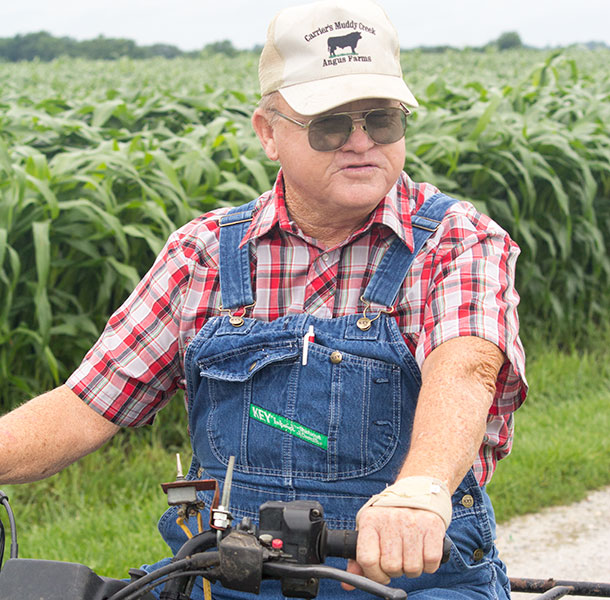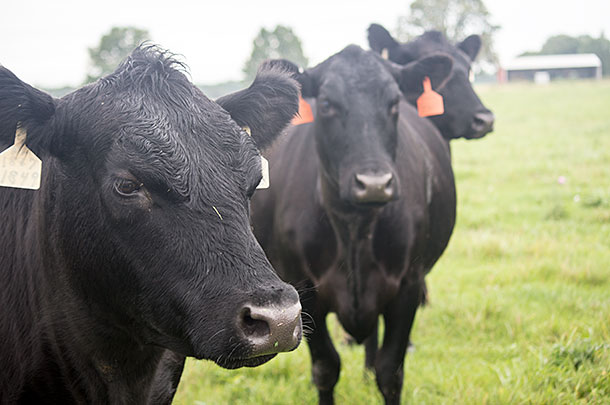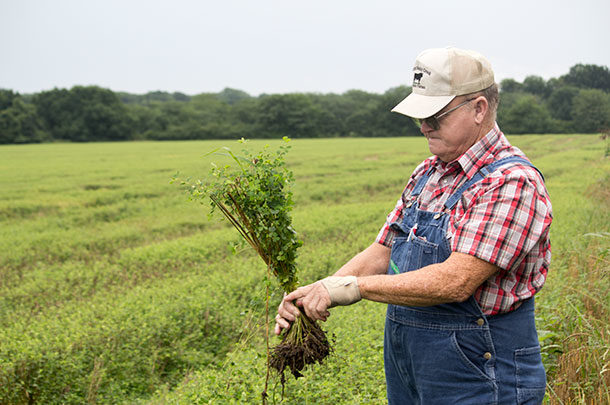Of that financially stressful time in farming, David says, “We were lucky to survive. We were blessed to survive. We paid 80 acres off twice – that’s how we got through it. Our faith got us through it.”
The Carriers, with their son Chuck and grandson Isaac, farm in southwest Missouri, near Lockwood. They also have a cow-calf herd of 250 registered Black Angus, and Isaac adds 35 Red Angus cows of his own. Carolyn (a retired schoolteacher) keeps the books.
The 1980s left an indelible impression upon David to farm conservatively and be open to new things – both qualities needed to survive hard times. He says, “My dad lived through the Depression, so he knew how to conserve.” Carrier recalls the first time he spent $6,000 on a bull to improve the herd, and his dad wouldn’t speak to him for the rest of the day. He says, “I tried to remember that lesson.”
Carrier says, “I try to have an open mind. I’ve experimented with several things.”

In 1948, his grandfather planted the first Kentucky 31 fescue, and lots of folks in the area are still growing it. Carrier started tearing out the original seeding several years ago. He says, “People seem reluctant to tear up old fescue, but the new fescues – BarOptima, MaxQ and others – are real improvements. They make good hay and good grazing pastures.”
More recently, he’s tried Marshall ryegrass, and says, “You can’t abuse ryegrass like fescue, but the tonnage is great, and it makes great pasture – 15 to 16 percent protein.” Carrier also has some straight red clover, and RFV on that hay has been in the 120 to 130 range.
Carrier says, “We try a lot of new stuff. This year we’re growing sorghum silage. It’s supposed to reach 7 feet high. We planted 28 acres and are hoping to get 30 tons to the acre. We’ll see.”
They have also tried canola and crested wheatgrass. He takes a hay harvest from about 500 acres of hay in any year, some of which is “crappy fescue” (harvested after seed has been harvested), ryegrass, red clover and fescue.
Carrier rents a lot of the ground he farms and sometimes struggles to get the rented fields up to his quality expectations. Lately, on one farm, he has struggled with blackberry briers, and has tilled and mowed to remove it. He uses chicken litter and soil tests to condition the soil and prepare it for capacity production. Carolyn says, “He’s a steward of the soil; he always wants to make the farms better.”
Carrier says, “We bought a McHale baler and bale wrapper. It takes a little bit more effort to feed them because of the plastic, but this year so far we’ve put up 1,900 bales. We usually get one cut on the pastures and then graze them. This year – a wet year – we’ll get two cuts before we graze.”

Carrier sells his breeding stock through private sales, and says he hasn’t bought females for the herd for 20 years. They use synchronization and A.I. for 50 percent of the total herd. He weans calves in April and September, using spring and fall calving. Calves usually wean at 600 to 700 pounds, with no creep feeding.
In addition, his grandson Isaac custom backgrounds 70 steers and 50 heifers, taking them from 600 to 700 pounds up to 800 to 900 pounds.
The home place was purchased in 1882, and Isaac is the sixth generation to live in the original house.
“My brother is a minister,” Carrier says, and adds with a grin, “In 1967, God called me to be a farmer; my brother didn’t have enough faith to be a farmer.”
Faith most always wears overalls. FG
PHOTO 1: One of the many forages David Carrier has tried is lespedeza. Other forage experiments have included Marshall ryegrass and the newer fescue varieties.
PHOTO 2: In southwest Missouri, David Carrier checks an experimental field of sorghum silage. He’s hoping for 30 tons to the acre.
PHOTO 3: David and Carolyn Carrier have a cow-calf herd of registered Black Angus, and they haven't bought any females off-farm for 20 years. Photos by Lynn Jaynes.












